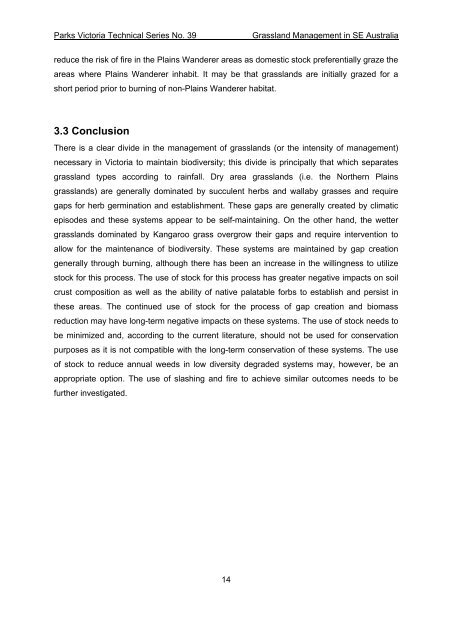Review of Grassland Management in south-eastern ... - Parks Victoria
Review of Grassland Management in south-eastern ... - Parks Victoria
Review of Grassland Management in south-eastern ... - Parks Victoria
You also want an ePaper? Increase the reach of your titles
YUMPU automatically turns print PDFs into web optimized ePapers that Google loves.
<strong>Parks</strong> <strong>Victoria</strong> Technical Series No. 39<br />
<strong>Grassland</strong> <strong>Management</strong> <strong>in</strong> SE Australia<br />
reduce the risk <strong>of</strong> fire <strong>in</strong> the Pla<strong>in</strong>s Wanderer areas as domestic stock preferentially graze the<br />
areas where Pla<strong>in</strong>s Wanderer <strong>in</strong>habit. It may be that grasslands are <strong>in</strong>itially grazed for a<br />
short period prior to burn<strong>in</strong>g <strong>of</strong> non-Pla<strong>in</strong>s Wanderer habitat.<br />
3.3 Conclusion<br />
There is a clear divide <strong>in</strong> the management <strong>of</strong> grasslands (or the <strong>in</strong>tensity <strong>of</strong> management)<br />
necessary <strong>in</strong> <strong>Victoria</strong> to ma<strong>in</strong>ta<strong>in</strong> biodiversity; this divide is pr<strong>in</strong>cipally that which separates<br />
grassland types accord<strong>in</strong>g to ra<strong>in</strong>fall. Dry area grasslands (i.e. the Northern Pla<strong>in</strong>s<br />
grasslands) are generally dom<strong>in</strong>ated by succulent herbs and wallaby grasses and require<br />
gaps for herb germ<strong>in</strong>ation and establishment. These gaps are generally created by climatic<br />
episodes and these systems appear to be self-ma<strong>in</strong>ta<strong>in</strong><strong>in</strong>g. On the other hand, the wetter<br />
grasslands dom<strong>in</strong>ated by Kangaroo grass overgrow their gaps and require <strong>in</strong>tervention to<br />
allow for the ma<strong>in</strong>tenance <strong>of</strong> biodiversity. These systems are ma<strong>in</strong>ta<strong>in</strong>ed by gap creation<br />
generally through burn<strong>in</strong>g, although there has been an <strong>in</strong>crease <strong>in</strong> the will<strong>in</strong>gness to utilize<br />
stock for this process. The use <strong>of</strong> stock for this process has greater negative impacts on soil<br />
crust composition as well as the ability <strong>of</strong> native palatable forbs to establish and persist <strong>in</strong><br />
these areas. The cont<strong>in</strong>ued use <strong>of</strong> stock for the process <strong>of</strong> gap creation and biomass<br />
reduction may have long-term negative impacts on these systems. The use <strong>of</strong> stock needs to<br />
be m<strong>in</strong>imized and, accord<strong>in</strong>g to the current literature, should not be used for conservation<br />
purposes as it is not compatible with the long-term conservation <strong>of</strong> these systems. The use<br />
<strong>of</strong> stock to reduce annual weeds <strong>in</strong> low diversity degraded systems may, however, be an<br />
appropriate option. The use <strong>of</strong> slash<strong>in</strong>g and fire to achieve similar outcomes needs to be<br />
further <strong>in</strong>vestigated.<br />
14

















